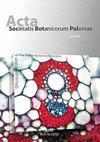波兰古植物学:一个世纪的研究揭示了7.5亿年的植物历史。古生代微生物区系
IF 1.1
4区 生物学
Q3 PLANT SCIENCES
引用次数: 0
摘要
波兰古生代的所有孢粉学研究都是在过去100年中进行的。调查发现了最古老的微生物区系遗迹、前寒武纪的分支、后来出现的孢子和花粉粒。孢粉学分析的主要好处是它们的地层意义、用于年龄测定、地层层位对比、气候变化检测和植物覆盖信息,通常为大型植物群记录提供补充数据。波兰孢粉学最重要的成果表明了研究的多面性及其科学意义。本文章由计算机程序翻译,如有差异,请以英文原文为准。
Polish Palaeobotany: 750 Million Years of Plant History as Revealed in a Century of Studies. Palaeozoic Microflora
All the palynological studies of the Polish Paleozoic were conducted during the last 100 years. The investigations regarded the oldest microflora remains, acritarchs reaching up to Precambrian, and spores, and pollen grains which appeared later. The main benefits of palynological analyses are their stratigraphic significance, usage for age determination, correlation of stratigraphic horizons, detection of climatic changes, and information on plant cover, often providing supplementary data for macroflora records. The most important results of Polish palynology demonstrate the multifaceted character of studies and their significance in science.
求助全文
通过发布文献求助,成功后即可免费获取论文全文。
去求助
来源期刊
CiteScore
2.00
自引率
10.00%
发文量
18
审稿时长
1 months
期刊介绍:
The journal has been published since 1923 and offers Open Access publication of original research papers, short communications, and reviews in all areas of plant science, including evolution, ecology, genetics, plant structure and development, physiology and biochemistry.

 求助内容:
求助内容: 应助结果提醒方式:
应助结果提醒方式:


